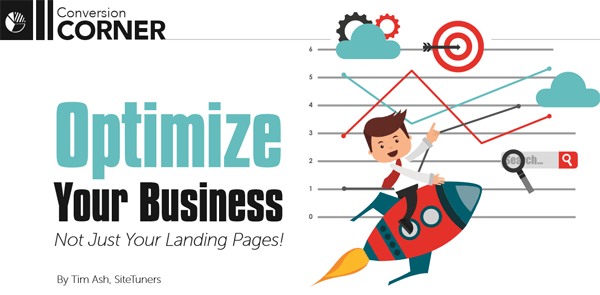Unleashing Total Business Optimization

by Tim Ash
16 Jan, 2023

Many online marketers conduct split tests and think they are running a real conversion rate optimization (CRO) program.
This is a dangerous misconception, not because testing is not valuable, but because testing is a fraction of what is needed in order to optimize an online business. People who are only running tests can get complacent, and not capture the full value available.
The Limitations of Split Testing
Split testing is something that can only be performed under a specific set of circumstances:
+ It is traffic intensive, so most of the pages on a site probably will not have enough traffic to test.
+ Split tests can validate existing ideas, but not create new ones; it will only work on the areas where enterprises have a viable set of good ideas to try.
+ Due to strong biasing effects on the people who have been exposed to previous communications, split testing on an in-house email list is not recommended.
+ Unless an enterprise's traffic is very steady, seasonality can wreak havoc and render results invalid.
Even if brands can pass all of the hurdles for running split tests, stakeholders need to understand they will not get very far simply by testing.
Rather, what they need is a complete conversion optimization program spanning multiple areas of operation including user experience, marketing technology, and a detailed operational knowledge of the business and internal culture.
Stop fiddling
Sometimes incremental tinkering can make companies a little bit more money, but optimizing within a horrible online experience will distract from crippling and deeper flaws. Sometimes enterprises need to throw it all away and start over.
Unfortunately, many companies do not like to dedicate the resources or time to properly redesign their site from a visitor's perspective. Often, the gains from simultaneously fixing multiple issues across a site experience can be massive (and can serve as the new and improved baseline from which to conduct additional fine-tuning through testing if necessary).
Most testing programs focus on efficiency metrics like testing velocity (number of tests per unit time) and not when it should stop. It is an optimizer's job to declare "the emperor has no clothes," and when it is time for a complete redesign (during which testing should completely stop).
Go beyond the measurable
Testing tools and analytics give us the false illusion that everything is measurable. Usually, when people say they have uncovered site issues, they do so by using quantitative tools like analytics and session recording.
Yes, it is true marketers can spot high bounce rates, a long time spent completing forms and other indicators of poor site experience. It is also true, however, we have to go beyond the comfort zone of measurable and comfortable reports and spreadsheets.
Quantitative tools will report the size of a potential problem, but not the critical "why" behind it. To figure out the "why," optimizers can interview potential customers, conduct usability tests and maybe even talk to those overworked customer service reps (who spend all day interacting with clients).
Yes, I know this advice thus far sounds squishy and unscientific - and it is. Acting on a single key insight uncovered from qualitative methods, however, can turbocharge a business overnight. Looking in the rearview mirror of quantitative site performance cannot set the direction for a profitable future.
Evaluate mar-tech
Testing-focused companies mostly rely on the following technology components: a content management system, a testing tool and an analytics platform. This is only the tip of the iceberg in optimization technology.
+ Tracking every aspect of prospect interactions (website visits, email clicks, downloads) will allow brands to effectively communicate with them when they are off of their site. A real marketing automation platform for personalized rule-based emails is critical to success.
+ Not everyone responds best to the same site experience, yet most testing tools simply provide the best "on average" version of a site. Marketers need to go beyond this norm by segmenting and personalizing the experience based on a visitor's past actions.
+ Depending on a company's data maturity, enterprises might need to bring in all their available customer and website information into a single data warehouse, where they can run reports and develop predictive models of prospects and their value. This means Web professionals need to get more comfortable with business intelligence and data science.
+ Online marketing does not just stop with websites and emails. Depending on the business, enterprises may also need to optimize their call center and chat support (including call analytics, rep training and evaluation and chat/trouble-ticket infrastructure).
If brands attempt to tough it out without upgrading their marketing technology stack, they will be left behind by more nimble players in their industry. Much of the advantage of the systems described here is they cannot be easily seen or copied, so many enterprises get outflanked without knowing it.
Get some executive support
Some of the projects and tools described above may require significant resources; without high level buy-in or sponsorship from key executives, marketers will not be able to get real optimization done. It is important for Web professionals to speak the language of money - make the business case for larger projects and show how much lost opportunity is costing the company with its current roadblocks.
Change the mindset
Over time, an enterprise's goal should be to change the culture of the company to focus more on optimization. Some signs of progress include:
+ People become more skeptical and start to actively look for Web usability problems.
+ The rationale for making changes is motivated by Web visitor satisfaction.
+ Well-defined processes spring up for collecting and sharing information about site performance.
+ Silos between marketing, sales, IT and customer service start to dissolve as people cooperate.
Don't be a greedy marketer
Most testing happens at the bottom of the sales funnel, which definitely provides a clear return on investment.
Optimizing the complete customer journey, however, is much more powerful. By providing real value to early stage visitors to their site, marketers get to open and continue an online conversation with prospects, and get access to them before competitors.
This comprehensive approach should start with creating useful and durable content to educate consumers, which can be accomplished in the form of videos, downloads or even interactive wizards to help guide visitors while educating them. The payoff from such full-lifecycle marketing is usually multiples of bottom-of-the-funnel direct response campaigns.
Broaden Your Focus…
True optimization requires a focus on attracting, persuading, and serving customers and prospects. If you want to have a real impact outside of simply improving online campaign performance, you have to take a broader view of optimization (see below).
Digital Growth Unleashed

Since 2010, I have chaired Conversion Conference in the U.S. and Europe. We covered every aspect of conversion rate optimization in detail. The ideas outlined in this article led me to change the show concept to cover all of the aspects of true optimization. The new show, Digital Growth Unleashed, is premiering at the Mandalay Bay in Las Vegas on May 16-17, 2018 to cover all aspects of growing an online business. We hope to see you there.
" Tim Ash, CEO of SiteTuners, Chair of Digital Growth Unleashed (formerly Conversion Conference) and bestselling author of "Landing Page Optimization."
Tim Ash
Tim Ash is the CEO of SiteTuners, Chair of Conversion Conference and bestselling author of "Landing Page Optimization."
Subscribe to Our Newsletter!
Latest in Marketing








